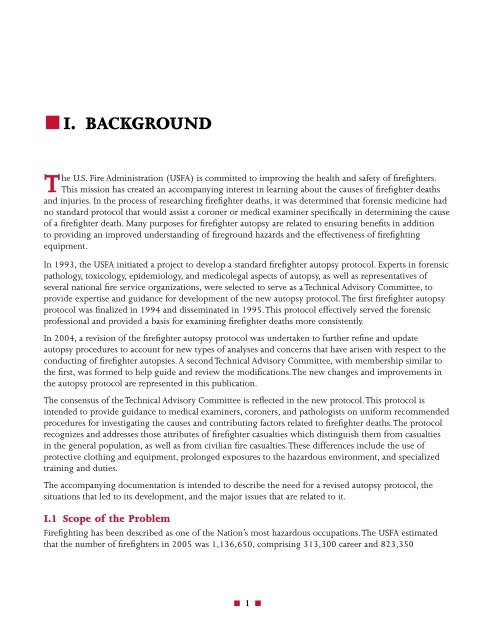Firefighter Autopsy Protocol - US Fire Administration - Federal ...
Firefighter Autopsy Protocol - US Fire Administration - Federal ...
Firefighter Autopsy Protocol - US Fire Administration - Federal ...
You also want an ePaper? Increase the reach of your titles
YUMPU automatically turns print PDFs into web optimized ePapers that Google loves.
■■I. BACKGROUND<br />
The U.S. <strong>Fire</strong> <strong>Administration</strong> (<strong>US</strong>FA) is committed to improving the health and safety of firefighters.<br />
This mission has created an accompanying interest in learning about the causes of firefighter deaths<br />
and injuries. In the process of researching firefighter deaths, it was determined that forensic medicine had<br />
no standard protocol that would assist a coroner or medical examiner specifically in determining the cause<br />
of a firefighter death. Many purposes for firefighter autopsy are related to ensuring benefits in addition<br />
to providing an improved understanding of fireground hazards and the effectiveness of firefighting<br />
equipment.<br />
In 1993, the <strong>US</strong>FA initiated a project to develop a standard firefighter autopsy protocol. Experts in forensic<br />
pathology, toxicology, epidemiology, and medicolegal aspects of autopsy, as well as representatives of<br />
several national fire service organizations, were selected to serve as a Technical Advisory Committee, to<br />
provide expertise and guidance for development of the new autopsy protocol. The first firefighter autopsy<br />
protocol was finalized in 1994 and disseminated in 1995. This protocol effectively served the forensic<br />
professional and provided a basis for examining firefighter deaths more consistently.<br />
In 2004, a revision of the firefighter autopsy protocol was undertaken to further refine and update<br />
autopsy procedures to account for new types of analyses and concerns that have arisen with respect to the<br />
conducting of firefighter autopsies. A second Technical Advisory Committee, with membership similar to<br />
the first, was formed to help guide and review the modifications. The new changes and improvements in<br />
the autopsy protocol are represented in this publication.<br />
The consensus of the Technical Advisory Committee is reflected in the new protocol. This protocol is<br />
intended to provide guidance to medical examiners, coroners, and pathologists on uniform recommended<br />
procedures for investigating the causes and contributing factors related to firefighter deaths. The protocol<br />
recognizes and addresses those attributes of firefighter casualties which distinguish them from casualties<br />
in the general population, as well as from civilian fire casualties. These differences include the use of<br />
protective clothing and equipment, prolonged exposures to the hazardous environment, and specialized<br />
training and duties.<br />
The accompanying documentation is intended to describe the need for a revised autopsy protocol, the<br />
situations that led to its development, and the major issues that are related to it.<br />
I.1 Scope of the Problem<br />
<strong>Fire</strong>fighting has been described as one of the Nation’s most hazardous occupations. The <strong>US</strong>FA estimated<br />
that the number of firefighters in 2005 was 1,136,650, comprising 313,300 career and 823,350<br />
■ 1 ■
















